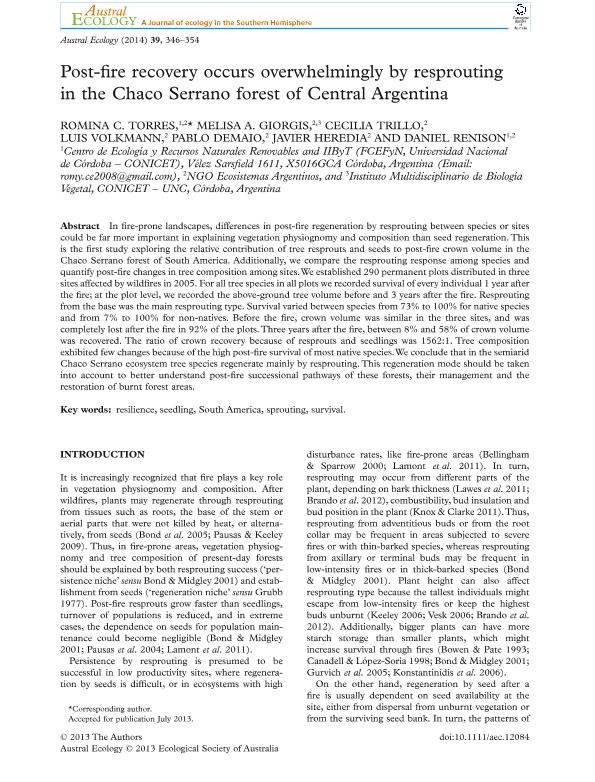Mostrar el registro sencillo del ítem
dc.contributor.author
Torres, Romina Cecilia

dc.contributor.author
Giorgis, Melisa Adriana

dc.contributor.author
Trillo, Cecilia

dc.contributor.author
Volkmann, Luis
dc.contributor.author
Demaio, Pablo Horacio

dc.contributor.author
Heredia, Javier
dc.contributor.author
Renison, Daniel

dc.date.available
2017-08-16T19:22:29Z
dc.date.issued
2014-05
dc.identifier.citation
Torres, Romina Cecilia; Giorgis, Melisa Adriana; Trillo, Cecilia; Volkmann, Luis; Demaio, Pablo Horacio; et al.; Post-fire recovery occurs overwhelmingly by resprouting in the Chaco Serrano forest of Central Argentina; Wiley Blackwell Publishing, Inc; Austral Ecology; 39; 3; 5-2014; 346-354
dc.identifier.issn
1442-9985
dc.identifier.uri
http://hdl.handle.net/11336/22540
dc.description.abstract
In fire-prone landscapes, differences in post-fire regeneration by resprouting between species or sitescould be far more important in explaining vegetation physiognomy and composition than seed regeneration. Thisis the first study exploring the relative contribution of tree resprouts and seeds to post-fire crown volume in theChaco Serrano forest of South America. Additionally, we compare the resprouting response among species andquantify post-fire changes in tree composition among sites.We established 290 permanent plots distributed in threesites affected by wildfires in 2005. For all tree species in all plots we recorded survival of every individual 1 year afterthe fire; at the plot level, we recorded the above-ground tree volume before and 3 years after the fire. Resproutingfrom the base was the main resprouting type. Survival varied between species from 73% to 100% for native speciesand from 7% to 100% for non-natives. Before the fire, crown volume was similar in the three sites, and wascompletely lost after the fire in 92% of the plots.Three years after the fire, between 8% and 58% of crown volumewas recovered. The ratio of crown recovery because of resprouts and seedlings was 1562:1. Tree compositionexhibited few changes because of the high post-fire survival of most native species.We conclude that in the semiaridChaco Serrano ecosystem tree species regenerate mainly by resprouting. This regeneration mode should be takeninto account to better understand post-fire successional pathways of these forests, their management and therestoration of burnt forest areas.
dc.format
application/pdf
dc.language.iso
eng
dc.publisher
Wiley Blackwell Publishing, Inc

dc.rights
info:eu-repo/semantics/openAccess
dc.rights.uri
https://creativecommons.org/licenses/by-nc-sa/2.5/ar/
dc.subject
Resilience
dc.subject
Seedling
dc.subject
Sprouting
dc.subject
Survival
dc.subject.classification
Bioquímica y Biología Molecular

dc.subject.classification
Ciencias Biológicas

dc.subject.classification
CIENCIAS NATURALES Y EXACTAS

dc.title
Post-fire recovery occurs overwhelmingly by resprouting in the Chaco Serrano forest of Central Argentina
dc.type
info:eu-repo/semantics/article
dc.type
info:ar-repo/semantics/artículo
dc.type
info:eu-repo/semantics/publishedVersion
dc.date.updated
2017-08-01T13:59:07Z
dc.identifier.eissn
1442-9993
dc.journal.volume
39
dc.journal.number
3
dc.journal.pagination
346-354
dc.journal.pais
Reino Unido

dc.journal.ciudad
Londres
dc.description.fil
Fil: Torres, Romina Cecilia. Consejo Nacional de Investigaciones Científicas y Técnicas. Centro Científico Tecnológico Conicet - Córdoba. Instituto de Investigaciones Biológicas y Tecnológicas. Universidad Nacional de Córdoba. Facultad de Ciencias Exactas, Físicas y Naturales. Instituto de Investigaciones Biológicas y Tecnológicas; Argentina. Ecosistemas Argentinos; Argentina
dc.description.fil
Fil: Giorgis, Melisa Adriana. Consejo Nacional de Investigaciones Científicas y Técnicas. Centro Científico Tecnológico Conicet - Córdoba. Instituto Multidisciplinario de Biología Vegetal. Universidad Nacional de Córdoba. Facultad de Ciencias Exactas Físicas y Naturales. Instituto Multidisciplinario de Biología Vegetal; Argentina. Ecosistemas Argentinos; Argentina
dc.description.fil
Fil: Trillo, Cecilia. Universidad Nacional de Córdoba. Facultad de Cs.exactas Físicas y Naturales. Departamento de Diversidad Biológica y Ecologica; Argentina. Ecosistemas Argentinos; Argentina
dc.description.fil
Fil: Volkmann, Luis. Ecosistemas Argentinos; Argentina
dc.description.fil
Fil: Demaio, Pablo Horacio. Universidad Nacional de Córdoba. Facultad de Ciencias Exactas, Físicas y Naturales; Argentina. Ecosistemas Argentinos; Argentina
dc.description.fil
Fil: Heredia, Javier. Ecosistemas Argentinos; Argentina
dc.description.fil
Fil: Renison, Daniel. Consejo Nacional de Investigaciones Científicas y Técnicas. Centro Científico Tecnológico Conicet - Córdoba. Instituto de Investigaciones Biológicas y Tecnológicas. Universidad Nacional de Córdoba. Facultad de Ciencias Exactas, Físicas y Naturales. Instituto de Investigaciones Biológicas y Tecnológicas; Argentina. Ecosistemas Argentinos; Argentina
dc.journal.title
Austral Ecology

dc.relation.alternativeid
info:eu-repo/semantics/altIdentifier/url/http://onlinelibrary.wiley.com/doi/10.1111/aec.12084/abstract
dc.relation.alternativeid
info:eu-repo/semantics/altIdentifier/doi/http://dx.doi.org/10.1111/aec.12084
Archivos asociados
